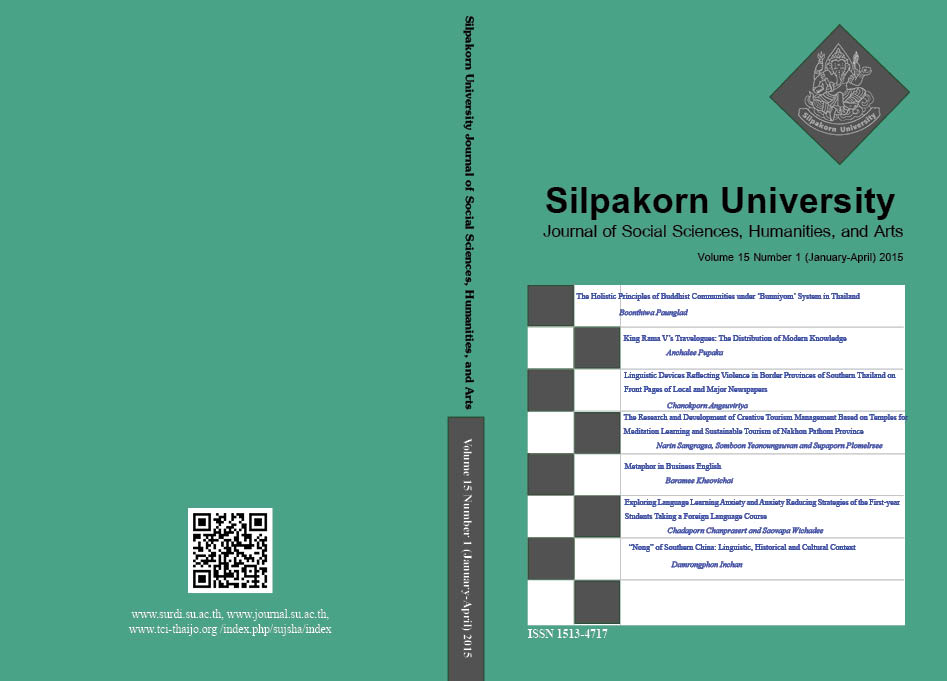Exploring Language Learning Anxiety and Anxiety Reducing Strategies of the First-year Students Taking a Foreign Language Course
Main Article Content
Abstract
Anxiety in the classroom is recognized as a negative factor that lessens the learner’s proficiency. This study investigated undergraduate students’ learning anxiety in a Japanese language course in a government university and examined strategies that students employed to reduce their anxiety. The instrument used for collecting the data was a five-rating scale questionnaire of the Foreign Language Classroom Anxiety Scale (Horwitz, Horwitz, and Cope, 1986). Data were collected from 116 first-year students enrolled in JP101 course in the first semester of 2013 academic year and analyzed by SPSS program using mean, standard deviation, Pearson Correlation Coefficient, and Chi-Square. The findings of the study revealed that students had moderate levels of learning anxiety and the use of anxiety reducing strategies. Four factors which were found to be related to students’ learning anxiety comprised Japanese language proficiency, experience of learning Japanese language, experience of using Japanese language with native speakers, and experience of traveling to Japan. However, gender and the use of anxiety reducing strategies were found to have no statistical relationship with learning anxiety. The findings encouraged the instructors to enrich their awareness of students’ language anxiety and carefully deal with those anxiety-provoking situations in the classroom.
Downloads
Article Details
All rights reserved. Apart from citations for the purposes of research, private study, or criticism and review,no part of this publication may be reproduced, stored or transmitted in any other form without prior written permission by the publisher.
References
Arnold, J. (2000) Seeing through Listening Comprehension Exam Anxiety. TESOL Quarterly 34(4): 777-786.
Bateman, T. and Zeithmal, C. (1989) The Psychological Context of Strategic Decisions: A Modeland Convergent Experimental Findings. Strategic Management Journal 10(2): 59–74.
Borg, S. (2006) The Distinctive Characteristics of Foreign Language Teachers. Language Teaching Research 10(1): 3–31.
Daly, J. (1991) Understanding Communication Apprehension: An introduction for Language Educators. In Language Anxiety: From Theory and Research to Classroom Implications, edited by Elaine K. Horwitz and Dolly J. Young, pp. 3-13. Englewood Cliffs, NJ: Prentice Hall.
Gardner, R., Tremblay, P. and Masgoret, A. (1997) Towards a Full Model of Language Learning. The Modern Language Journal 81(3): 344-362.
Hashimoto, Y. (2002) Motivation and Willingness to Communicate as Predictors of L2 Use: The Japanese ESL context. Second Language Studies 20(2): 29-70.
Horwitz, E., Horwitz, M. and Cope, J. (1986) Foreign Language Classroom Anxiety. The Modern Language Journal 70(2): 125-132.
Kondo, S. and Yang, Y. L. (2003) The English Language Classroom Anxiety Scale: Test Construction, Reliability, and Validity. JALT Journal 25(2): 23-40.
Krashen, S. (2003) Explorations in Language Acquisition and Use.Portsmouth: Heinemann.
Kwan, L. (2004) A Study of Language Anxiety and Motivational Intensity in Learning English as a Second Language in Hong Kong Secondary School. Hong Kong: Hong Kong Baptist University.
MacIntyre, P. D. (1995) How Does Anxiety Affect Foreign Language Learning: A Reply to Sparks and Ganschow. The Modern Language Journal 79(1): 90-99.
Rezazadeh, M. and Tavakoli, M. (2009) Investigating the Relationship among Test Anxiety, Gender, Academic Achievement and Years of Study: A Case of Iranian EFL University Students. English Language Teaching 2(4): 45-58.
Sa-nguanpong, S. (2007) The Relationship between Learning Anxiety in English Classroom and the English Proficiency of Thai Vocational Students. Master Thesis, Language Institute, Thammasart University, Bangkok, Thailand.
Scovel, T. (1978) The Effect of Affect: A Review of the Anxiety Literature. Language Learning 28, 129-142.
Scovel, T. (1991) The Effect of Affect on Foreign Language Learning: A Review of the Anxiety Research. In Horwitz, Language Anxiety: From Theory and Research to Classroom Implications, edited by Elaine K. Horwitz and Dolly J. Young, pp. 101-108. Englewood Cliffs. NJ: Prentice Hall.
Spielmann, G. and Radnofsky, M. (2001) Learning Language under Tension: New Directions from a Qualitative Study. The Modern Language Journal 85(2): 259-278.
Tajima, M. (2002) Motivation, Attitude, and Anxieties toward Learning English as a Foreign Language: A Survey of Japanese University Students in Tokyo. Gengo no Sekai 20(1): 115-155.
University of Cambridge Counseling Service. (2005) Angry. [Online URL: www.counselling.cam. ac.uk/selfhelp/leaflets/anger] accessed on August 13, 2005.
Yu-ching, D. and Wu, G. (2004) A Study of Foreign Language Anxiety of EFL Elementary School Students in Taipei. County Journal of National Taipei Teachers College 17(2): 287-320.
Wu, J. (2007) Comparison of Students’ Language Anxiety and Academic Achievement between Bilingual Instruction and Traditional EFL Instruction in an Elementary School in Taiwan. Dissertation. Texas A&M University - Kingsville, 196 pages; AAT 3274050.
Zhao, N. (2007) Study of High School Students’ English Learning Anxiety. Asian EFL Journal 9(3): 22.


